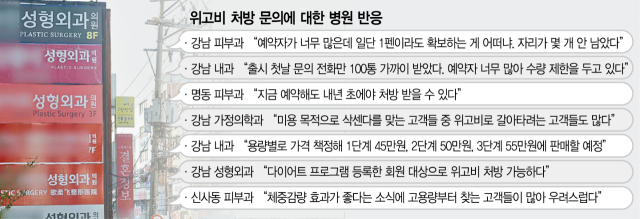■Inquiries about WEGOVI prescriptions at 40 hospitals and clinics in Seoul
Price difference from lowest 450,000 won to highest 1.09 million won
Possibility of price increase due to supply shortage of Wegobi ↑
Hospital diet product ‘linked sales’ trick
Register for a program worth millions of won
Prescribed for cosmetic purposes even at normal BMI
“Our hospital plans to sell Wegobee for 550,000 won per pen. “It’s cheaper than other hospitals, so there are too many reservations right now, so why don’t you secure at least 1 penny first?”
On the 16th, a dermatologist in Gangnam emphasized that it is not easy to obtain Wegobee, known as the ‘miracle obesity treatment’, and suggested making an appointment quickly. Consumer prices vary widely, up to 640,000 won, depending on the hospital, and some hospitals have even resorted to tricking existing diet products with premiums.
The Seoul Economic Daily inquired about prescriptions for Wigobi at 40 hospitals and clinics in Seoul on this day, and found that there was already a shortage. An official at a dermatology clinic in Myeongdong said, “We are sold out just by pre-ordering,” and added, “Even if you make a reservation now, you will only be able to receive a prescription early next year.” Most hospitals also expected delivery around late October to early to mid-November. However, from the hospital’s perspective, it was difficult to predict when the requested quantity would be supplied, so it was reluctant to provide information about the waiting period for reservations.
Novo Nordisk, the developer of Wegobee, limited the purchase amount to 2 pen per dose for new hospitals. As Wegobi is divided into 5 levels of dosage ranging from 0.25 to 2.4 mg in total, a single medical institution can purchase 6 units. As supply is absolutely insufficient compared to the high demand for Wigobi, there is a growing possibility that the price will skyrocket. This is because Wegobi is a non-reimbursed drug, so the hospital can set the price at its discretion. The domestic supply price of Wegobi is 372,025 won per pen (4 weeks), but the amount that patients actually have to pay is the pharmaceutical company’s factory price plus the distributor’s margin, taxes, and medical expenses. This is why it was predicted before launch that prices would vary widely across hospitals.
As a result of this newspaper’s coverage, the price per pen ranged from a minimum of 450,000 won to a maximum of 1,089,000 won, a difference of up to 640,000 won. Most were priced in the 700,000 to 800,000 won range, but if you could get it quickly, the price was usually higher. Perhaps out of consideration for the possibility of patients administering the expensive Wigobi injection incorrectly, some places set a condition that patients must visit the hospital in person to receive the injection. Wegobi is an injection that can be self-administered to the stomach or thighs.
Various concerns raised before launch were realized in the field. On the 15th, the first day of launch, only three low doses, 0.25 mg, 0.5 mg, and 1.0 mg, were released. The supply price is the same regardless of capacity. However, in some hospitals, prices are set differently depending on capacity. An internal medicine clinic in Gangnam announced that it plans to sell the first stage for 450,000 won, the second stage for 500,000 won, and the third stage for 550,000 won.
There were also hospitals that resorted to ‘tie-in sales’ to target shortages. At a plastic surgery clinic in Gangnam, one could only purchase Wegobi by registering for the hospital’s diet program, which costs 1 to 2 million won. Since the diet program includes a stomach upset, patients must register for the program by ‘eating mustard while crying’ in order to face the stomach upset.
It could be prescribed for cosmetic purposes, not for obesity treatment, without any particular restrictions. The target of prescription for Wigobi is ‘obese patients’ with a body mass index (BMI, weight divided by the square of height) of 30 kg/㎡ or more. However, in most hospitals, prescriptions were possible even if the BMI was within the normal range. Initially, there were many concerns that Wegobi would be misused for extreme weight loss. An official at a family medicine clinic in Gangnam said, “Currently, Saxenda can be used even if you are of normal weight,” and added, “There are many existing Saxenda customers who want to switch to Wegobi.” This means that patients’ interest in Wegobi has increased due to its convenience in administration, as it only needs to be taken once a week, unlike Saxenda, which needs to be administered every day.
Some hospital officials expressed concern over the intense interest in Wigobi. An official at a dermatology clinic in Sinsa-dong said, “After hearing that Wigobi has a good weight loss effect, many customers start looking for high doses, so in some cases we do not recommend it,” and added, “It is advisable to use it only as an auxiliary means for weight loss.”


